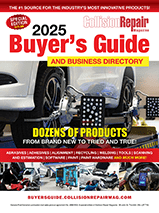By Mike Davey
Pros make it look easy. Here’s how to start with the basics.
Mechanical pinstriping kits are sometimes used when a long straight stripe is required, say along a bodyline. However, they cannot give the same breathtaking results as freehand methods.
So you want to give pinstriping a shot? The professionals make it look easy, but even the simplest design can turn out poorly without good planning and prep. Professional pinstripers spend years honing their craft and their abilities. It’s best to start with something simple and practice, practice, practice before you try it on a vehicle, even one of your own. There are a number of pinstriping methods. Mechanical pinstriping is one method that may be attractive to someone just starting out. One of the big advantages of a mechanical striper is that it lays down stripes of a consistent width, meaning you can concentrate more on keeping your lines straight or contoured, depending on your design. Adding in a magnetic pinstriping strip can help guide your hand, helping you to achieve consistency. Pros make it look easy. Here’show to start with the basics.Dan “Danno” Drouinis a professionalpinstriper working outof Brantford, Ontario.He walks us throughthe basics of thisclassic automotive enhancement.
Stencil tape is also an option. These allow you to paint stripes of various colours without waiting for others to dry. Run the tape along where you wish to paint. Make sure you press out the air bubbles as you go, as paint can bleed into these pockets, ruining the effect.
There’s no doubt that these techniques work, but for flexibility and results they can’t beat freehand striping. Naturally, it’s also the hardest to master. Dan “Danno” Drouin has been a professional pinstriper for over 30 years. He recently sat down with Bodyworx Professional to give us some pointers.
1. Start with a design. Sketching it out on paper will allow you to finalize the details and helps make sure the design you have in mind works visually. A good marker will allow you to draw both thick and thin lines. As you gain experience with the process, you’ll feel more confident in winging it.
2. Pick your colours. This is more a matter of personal taste than anything else, but limiting yourself to no more than two colours to start with is a good idea. Too many colours will look too busy. Choose colours that provide contrast and look good with the colour of the material you’re striping.
3. Give yourself a visual guide. This can be as simple as a strip of tape, but Danno recommends drawing a grid. “I’ve seen stuff drawn without a grid that might look okay first glance, but the unevenness of the designs jumps out at me right away. Even if you don’t know why, you’ll know something isn’t right.”
4. You can lay out a grid of 1-inch squares directly onto most materials with a soft pencil. These are available at art supply stores. The pencil lines do not interfere with paint adhering to the material, and you can wash them off with water when the design is complete.
5. Load your brush with paint. Remove excess by running it over an old glossy magazine or piece of scrap metal or plastic.
6. Start striping. Hold the brush between your thumb and forefinger. Hold it at the ferrule (the part where the bristles connect to the handle) with the fl at side facing away from you.
7. Use a consistent even pressure to make consistent even lines.
8. Curves should be smooth and balanced. Check against both the grid and the other lines already completed to ensure that they match and provide symmetry.
9. Start striping with your second colour! Follow the same procedures again to lay down the second part of your design. While it’s possible to have a one-colour design, two colours helps the design stand out and lends an illusion of perspective.
Equipment and tools
 First off, you’re probably going to need at least one striping brush. Like any kind of paintbrush, there is enormous variability in quality between manufacturers. There’s a tendency for people just starting out to go for cheap equipment. However, this may not be a good move. Cheaper brushes tend to be harder to work with than more expensive ones. When you’re just starting out, go for the middle of the road. Find a sweet spot between price and quality, and make sure the brush feels right for you.
First off, you’re probably going to need at least one striping brush. Like any kind of paintbrush, there is enormous variability in quality between manufacturers. There’s a tendency for people just starting out to go for cheap equipment. However, this may not be a good move. Cheaper brushes tend to be harder to work with than more expensive ones. When you’re just starting out, go for the middle of the road. Find a sweet spot between price and quality, and make sure the brush feels right for you.
Second, you’ll need some paint. The most common brand name is 1-shot. It’s widely available in art stores and from sign painting suppliers. Building a big library of colours off the bat is going to be prohibitively expensive. Pick out a couple of colours you really like the look of and suit what you have in mind. You can always expand your collection later.
 Brushes vary widely in quality and price. Find the one that works for you.
Brushes vary widely in quality and price. Find the one that works for you.
1-shot is a brand name, but it’s common enough that many people use the term generically.
























